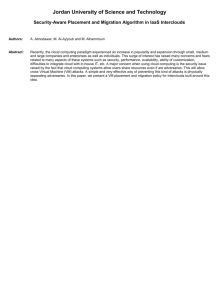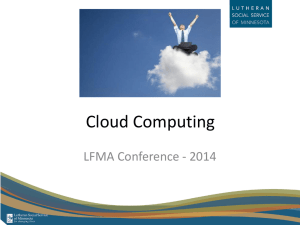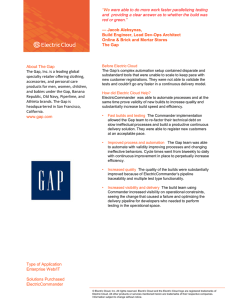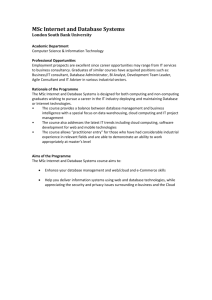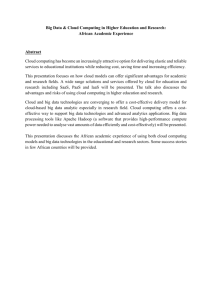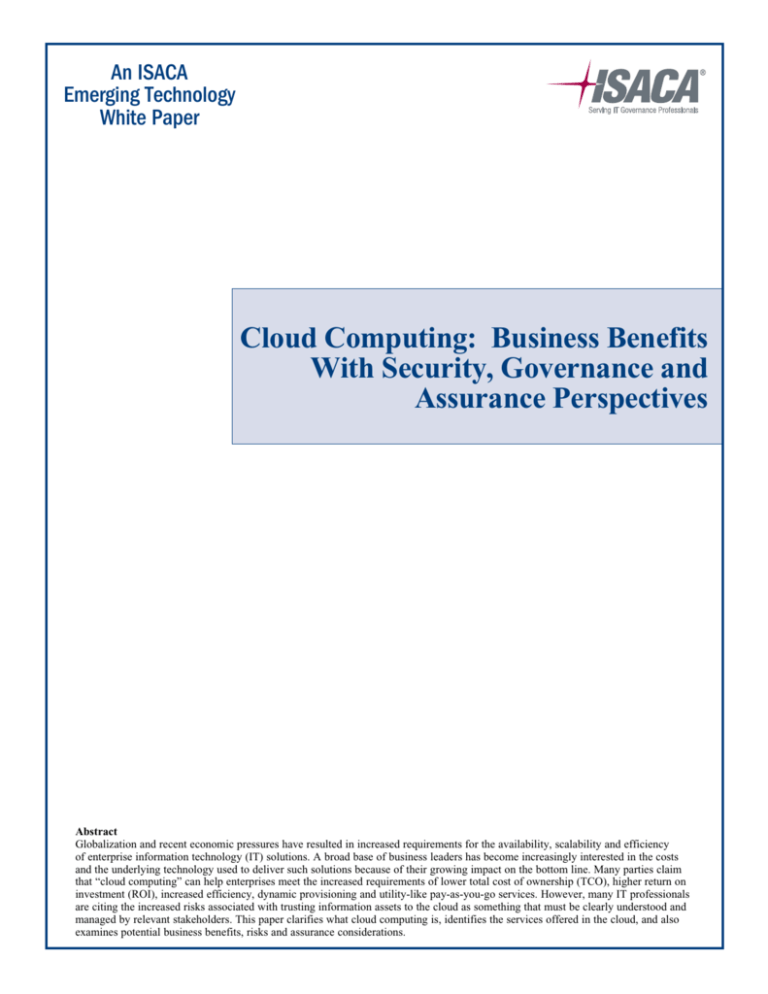
An ISACA
Emerging Technology
White Paper
Cloud Computing: Business Benefits
With Security, Governance and Assurance Perspectives
Abstract
Globalization and recent economic pressures have resulted in increased requirements for the availability, scalability and efficiency
of enterprise information technology (IT) solutions. A broad base of business leaders has become increasingly interested in the costs
and the underlying technology used to deliver such solutions because of their growing impact on the bottom line. Many parties claim
that “cloud computing” can help enterprises meet the increased requirements of lower total cost of ownership (TCO), higher return on
investment (ROI), increased efficiency, dynamic provisioning and utility-like pay-as-you-go services. However, many IT professionals
are citing the increased risks associated with trusting information assets to the cloud as something that must be clearly understood and
managed by relevant stakeholders. This paper clarifies what cloud computing is, identifies the services offered in the cloud, and also
examines potential business benefits, risks and assurance considerations.
Cloud Computing: Business Benefits With Security, Governance
and Assurance Perspectives
ISACA®
With more than 86,000 constituents in more than 160 countries, ISACA (www.isaca.org) is a leading global provider of
knowledge, certifications, community, advocacy and education on information systems assurance and security, enterprise
governance of IT, and IT-related risk and compliance. Founded in 1969, ISACA sponsors international conferences, publishes
the ISACA® Journal, and develops international information systems auditing and control standards. It also administers the
globally respected Certified Information Systems Auditor™ (CISA®), Certified Information Security Manager® (CISM®) and
Certified in the Governance of Enterprise IT® (CGEIT®) designations.
ISACA developed and continually updates the CobiT,® Val IT™ and Risk IT frameworks, which help IT professionals and
enterprise leaders fulfill their IT governance responsibilities and deliver value to the business.
Disclaimer
ISACA has designed and created Cloud Computing: Business Benefits With Security, Governance and Assurance
Perspectives (the “Work”), primarily as an educational resource for security, governance and assurance professionals. ISACA
makes no claim that use of any of the Work will assure a successful outcome. The Work should not be considered inclusive
of any proper information, procedures and tests or exclusive of other information, procedures and tests that are reasonably
directed to obtaining the same results. In determining the propriety of any specific information, procedure or test, security,
governance and assurance professionals should apply their own professional judgment to the specific control circumstances
presented by the particular systems or information technology environment.
Reservation of Rights
© 2009 ISACA. All rights reserved. No part of this publication may be used, copied, reproduced, modified, distributed,
displayed, stored in a retrieval system or transmitted in any form by any means (electronic, mechanical, photocopying,
recording or otherwise) without the prior written authorization of ISACA. Reproduction and use of all or portions of this
publication are permitted solely for academic, internal and noncommercial use and for consulting/advisory engagements, and
must include full attribution of the material’s source. No other right or permission is granted with respect to this work.
ISACA
3701 Algonquin Road, Suite 1010
Rolling Meadows, IL 60008 USA
Phone: +1.847.253.1545
Fax: +1.847.253.1443
E-mail: info@isaca.org
Web site: www.isaca.org
Cloud Computing: Business Benefits With Security, Governance and Assurance Perspectives
CGEIT is a trademark/service mark of ISACA. The mark has been applied for or registered in countries throughout the world.
2
© 2009 ISACA. A
l l
r i g h t s
r e s e r v e d
.
Cloud Computing: Business Benefits With Security, Governance
and Assurance Perspectives
ISACA wishes to recognize:
Project Development Team
Jeff Spivey, CPP, PSP, Security Risk Management, Inc., USA, Chair
Phil Agcaoili, CISM, CISSP, Dell, USA
Joshua Davis, CISA, CISM, CIPP, CISSP, Qualcomm Inc., USA
Geir Arild Engh-Hellesvik, Ernst & Young AS, Norway
David Lang, CISA, CISM, CISSP-ISSMP, CPP, PMP, Dell, USA
H. Peet Rapp, CISA, Rapp Consulting, USA
Jim Reavis, Cloud Security Alliance, USA
Ben Rothke, CISA, CISM, CGEIT, BT Global Services, USA
Joel Scambray, CISSP, Consciere, USA
Ward Spangenberg, CISA, CISSP, QSA, IOActive, USA
ISACA Board of Directors
Emil D’Angelo, CISA, CISM, Bank of Tokyo-Mitsubishi UFJ Ltd., USA, International President
George Ataya, CISA, CISM, CGEIT, CISSP, ICT Control SA, Belgium, Vice President
Yonosuke Harada, CISA, CISM, CGEIT, CAIS, InfoCom Research, Inc., Japan, Vice President
Jose Angel Pena Ibarra, CGEIT, Alintec, Mexico, Vice President
Ria Lucas, CISA, CGEIT, Telstra Corp., Australia, Vice President
Robert Stroud, CGEIT, CA Inc., USA, Vice President
Rolf von Roessing, CISA, CISM CGEIT, KPMG Germany, Germany, Vice President
Kenneth L. Vander Wal, CISA, CPA, Ernst & Young LLP (retired), USA, Vice President
Lynn Lawton, CISA, FBCS, CITP, FCA, FIIA, KPMG LLP, UK, Past International President
Everett Johnson, CPA, Deloitte & Touche LLP (Retired), USA, Past International President
Gregory T. Grocholski, CISA, The Dow Chemical Company, USA, Director
Tony Hayes, CGEIT, AFCHSE, CHE, FACS, FCPA, FIIA, Queensland Government, Australia, Director
Howard Nicholson, CISA, CGEIT, City of Salisbury, Australia, Director
Jeff Spivey, CPP, PSP, Security Risk Management, Inc., USA, Trustee
Guidance and Practices Committee
Kenneth L. Vander Wal, CISA, CPA, Ernst & Young LLP (retired), USA, Chair
Phil James Lageschulte, CGEIT, CPA, KPMG LLP, USA
Mark A. Lobel, CISA, CISM, CISSP, PricewaterhouseCoopers LLP, USA
Adel H. Melek, CISA, CISM, CGEIT, Deloitte & Touche, Canada
Ravi Muthukrishnan, CISA, CISM, FCA, ISCA, Capco IT Service India Pvt Ltd., India
Anthony P. Noble, CISA, Viacom, USA
Salomon Rico, CISA, CISM, CGEIT, Galaz, Yamazaki, Ruiz Urquiza, S.C., Mexico
Eddy Justin Schuermans, CISA, CGEIT, ESRAS bvba, Belgium
Frank Van Der Zwaag, CISA, CISSP, Westpac, New Zealand
The Cloud Security Alliance—for which ISACA is a founding member
© 2009 ISACA. A
l l
r i g h t s
r e s e r v e d
.
3
Cloud Computing: Business Benefits With Security, Governance
and Assurance Perspectives
Impacts of Cloud Computing
As CxOs search for ways to meet ever-increasing IT demands, many are closely examining cloud computing as a real
option for their enterprise needs. The promise of cloud computing is arguably revolutionizing the IT services world by
transforming computing into a ubiquitous utility, leveraging on attributes such as increased agility, elasticity, storage
capacity and redundancy to manage information assets. The continued influence and innovative use of the Internet has
enabled cloud computing to utilize existing infrastructure and transform it into services that could provide enterprises
both significant cost savings and increased efficiency. Enterprises are realizing there is a potential to leverage this
innovation to better serve customers and gain business advantage.
By offering enterprises the opportunity to decouple their IT needs and their infrastructure, cloud computing has the likely
ability to offer enterprises long-term IT savings, including reducing infrastructure costs and offering pay-for-service
models. By moving IT services to the cloud, enterprises can take advantage of using services in an on-demand model.
Less up-front capital expenditure is required, which allows businesses increased flexibility with new IT services.
For all these reasons, it is easy to see why cloud computing is an attractive potential service
offering for any business looking to enhance IT resources while controlling costs. However,
it should be noted that along with the benefits come risks and security concerns that must
be considered. As IT services are contracted outside of the enterprise, there is added risk
with increased dependency on a third-party provider to supply flexible, available, resilient
and efficient IT services. While many enterprises are accustomed to managing this type
of risk in-house, changes are required to expand governance approaches and structures to
appropriately handle the new IT solutions and enhance business processes.
As with any emerging technology, cloud computing offers the possibility of high reward in
terms of containment of costs and features such as agility and provisioning speed. However,
as a “new” initiative, it can also bring the potential for high risk. Cloud computing
introduces a level of abstraction between the physical infrastructure and the owner of the
information being stored and processed. Traditionally, the data owner has had direct or
indirect control of the physical environment affecting his/her data. In the cloud, this is no
longer the case. Due to this abstraction, there is already a widespread demand for greater
transparency and a robust assurance approach of the cloud computing supplier’s security
and control environment.
“The promise of
cloud computing
is arguably
revolutionizing the
IT services world
by transforming
computing into an
ubiquitous utility.”
Once it has been determined that cloud services are a plausible solution for an enterprise, it is important to identify the
business objectives and risks that accompany the cloud. This will assist enterprises in determining what types of data
should be trusted to the cloud, as well as which services might deliver the greatest benefit.
Just What Is Cloud Computing?
One of the most confusing issues surrounding the cloud and its related services is the lack of agreed-upon definitions. As
with all emerging technologies, the lack of clarity and agreement often hinders the overall evaluation and adoption of that
technology. Two groups that have offered a baseline of definitions are the National Institute of Standards and Technology
(NIST) and the Cloud Security Alliance. They both define cloud computing as a model for enabling convenient, on-demand
network access to a shared pool of configurable computing resources (e.g., networks, servers, storage, applications and
services) that can be rapidly provisioned and released with minimal management effort or service provider interaction.
Another way to describe services offered in the cloud is to liken them to that of a utility. Just as enterprises pay for the
electricity, gas and water they use, they now have the option of paying for IT services on a consumption basis.
4
© 2009 ISACA. A
l l
r i g h t s
r e s e r v e d
.
Cloud Computing: Business Benefits With Security, Governance
and Assurance Perspectives
The cloud model can be thought of as being composed of three service models (figure 1), four deployment models
(figure 2) and five essential characteristics (figure 3). Overall risks and benefits will differ per model and it is
important to note that when considering different types of service and deployment models, enterprises should consider
the risks that accompany them.
Figure 1—Cloud Computing Service Models
Service Model
Definition
To Be Considered
Infrastructure as a Service (IaaS)
Capability to provision processing, storage,
networks and other fundamental computing
resources, offering the customer the ability to
deploy and run arbitrary software, which can
include operating systems and applications.
IaaS puts these IT operations into the hands
of a third party.
Options to minimize the impact if the cloud
provider has a service interruption
Platform as a Service (PaaS)
Capability to deploy onto the cloud
infrastructure customer-created or acquired
applications created using programming
languages and tools supported by the
provider
• Availability
• Confidentiality
• Privacy and legal liability in the event of
a security breach (as databases housing
sensitive information will now be hosted
offsite)
• Data ownership
• Concerns around e-discovery
Software as a Service (SaaS)
Capability to use the provider’s applications
• Who owns the applications?
running on cloud infrastructure. The
• Where do the applications reside?
applications are accessible from various client
devices through a thin client interface such as
a web browser (e.g., web-based e-mail).
Figure 2—Cloud Computing Deployment Models
Deployment Model
Description of Cloud Infrastructure
To Be Considered
Private cloud
• Operated solely for an organization
• May be managed by the organization or a
third party
• May exist on-premise or off-premise
• Cloud services with minimum risk
• May not provide the scalability and agility of
public cloud services
Community cloud
• Shared by several organizations
• Supports a specific community that has
shared mission or interest.
• May be managed by the organizations or a
third party
• May reside on-premise or off-premise
• Same as private cloud, plus:
• Data may be stored with the data of
competitors.
Public cloud
• Made available to the general public or a
large industry group
• Owned by an organization selling cloud
services
• Same as community cloud, plus:
• Data may be stored in unknown locations
and may not be easily retrievable.
Hybrid cloud
A composition of two or more clouds
(private, community or public) that remain
unique entities but are bound together by
standardized or proprietary technology that
enables data and application portability
(e.g., cloud bursting for load balancing
between clouds)
• Aggregate risk of merging different
deployment models
• Classification and labeling of data will be
beneficial to the security manager to ensure
that data are assigned to the correct cloud
type.
© 2009 ISACA. A
l l
r i g h t s
r e s e r v e d
.
5
Cloud Computing: Business Benefits With Security, Governance
and Assurance Perspectives
Figure 3—Cloud Computing Essential Characteristics
Characteristic
Definition
On-demand self-service
The cloud provider should have the ability to automatically provision computing capabilities, such
as server and network storage, as needed without requiring human interaction with each service’s
provider.
Broad network access
According to NIST, the cloud network should be accessible anywhere, by almost any device
(e.g., smart phone, laptop, mobile devices, PDA).
Resource pooling
The provider’s computing resources are pooled to serve multiple customers using a multitenant
model, with different physical and virtual resources dynamically assigned and reassigned according
to demand. There is a sense of location independence. The customer generally has no control or
knowledge over the exact location of the provided resources. However, he/she may be able to
specify location at a higher level of abstraction (e.g., country, region or data center). Examples of
resources include storage, processing, memory, network bandwidth and virtual machines.
Rapid elasticity
Capabilities can be rapidly and elastically provisioned, in many cases automatically, to scale out
quickly and rapidly released to scale in quickly. To the customer, the capabilities available for
provisioning often appear to be unlimited and can be purchased in any quantity at any time.
Measured service
Cloud systems automatically control and optimize resource use by leveraging a metering capability
(e.g., storage, processing, bandwidth and active user accounts). Resource usage can be monitored,
controlled and reported, providing transparency for both the provider and customer of the utilized
service.
As can be observed in the characteristics listed in figure 3, there are many approaches and nuisances to cloud computing.
Benefits to the enterprise, as well as risks, will vary depending on the types of service and deployment models selected.
The Business Benefits of Cloud Computing
While the promise of financial savings is a very attractive enticement for cloud computing, quite possibly the cloud’s
best opportunity is for enterprises to streamline processes and increase innovation. It enables increasing productivity and
transforming business processes through means that were prohibitively expensive before the cloud. Organizations can
focus on their core business, rather than be concerned about scalability of infrastructure. Solving peak business demands
for performance can be readily met by using cloud computing—translating into more reliable backup, more satisfied
customers, increased scalability and even higher margins.
Some of the key business benefits offered by the cloud include:
• Cost containment—The cloud offers enterprises the option of scalability without the serious financial commitments
required for infrastructure purchase and maintenance. There is little to no upfront capital expenditure with cloud
services. Services and storage are available on demand and are priced as a pay-as-you-go service. Additionally,
the cloud model could assist with cost savings in terms of wasted resources. Saving on unused server space allows
enterprises to contain costs in terms of existing technology requirements and experiment with new technologies and
services without a large investment. Enterprises will need to compare current costs against potential cloud expenses and
consider models for TCO to understand whether cloud services will offer the enterprise potential savings.
• Immediacy—Many early adopters of cloud computing have cited the ability to provision and utilize a service in
a single day. This compares to traditional IT projects that may require weeks or months to order, configure and
operationalize the necessary resources. This has a fundamental impact on the agility of a business and the reduction of
costs associated with time delays.
• Availability—Cloud providers have the infrastructure and bandwidth to accommodate business requirements for
high speed access, storage and applications. As these providers often have redundant paths, the opportunity for load
balancing exists to ensure that systems are not overloaded and services delayed. While availability can be promised,
customers should take care to ensure that they have provisions in place for service interruptions.
6
© 2009 ISACA. A
l l
r i g h t s
r e s e r v e d
.
Cloud Computing: Business Benefits With Security, Governance
and Assurance Perspectives
• Scalability—With unconstrained capacity, cloud services offer increased flexibility and
scalability for evolving IT needs. Provisioning and implementation are done on demand,
allowing for traffic spikes and reducing the time to implement new services.
• Efficiency—Reallocating information management operational activities to the cloud
offers businesses a unique opportunity to focus efforts on innovation and research and
development. This allows for business and product growth and may be even more
beneficial than the financial advantages offered by the cloud.
• Resiliency—Cloud providers have mirrored solutions that can be utilized in a disaster
scenario as well as for load-balancing traffic. Whether there is a natural disaster requiring
a site in a different geographic area or just heavy traffic, cloud providers say they will have
the resiliency and capacity to ensure sustainability through an unexpected event.
The premise of the cloud is that by outsourcing portions of information management and
IT operations, enterprise workers will be free to improve processes, increase productivity
and innovate while the cloud provider handles operational activity smarter, faster and
cheaper. Assuming this to be the case, significant changes to the existing business processes
will likely be required to take advantage of the opportunities that cloud services offer.
“…by outsourcing
portions of
information
management and
IT operations,
enterprise
workers will be
free to improve
processes, increase
productivity and
innovate…”
Risks and Security Concerns With Cloud Computing
Many of the risks frequently associated with cloud computing are not new, and can be found in enterprises today. Well
planned risk management activities will be crucial in ensuring that information is simultaneously available and protected.
Business processes and procedures need to account for security, and information security managers may need to adjust
their enterprise’s policies and procedures to meet the business’s needs. Given the dynamic business environment and
focus on globalization, there are very few enterprises that do not outsource some part of their business. Engaging in a
relationship with a third party will mean that the business is not only using the services and technology of the cloud
provider, but also must deal with the way the provider runs its organization, the architecture the provider has in place,
and the provider’s organizational culture and policies. Some examples of cloud computing risks for the enterprise that
need to be managed include:
• Enterprises need to be particular in choosing a provider. Reputation, history and sustainability should all be factors to
consider. Sustainability is of particular importance to ensure that services will be available and data can be tracked.
• The cloud provider often takes responsibility for information handling, which is a critical part of the business. Failure
to perform to agreed-upon service levels can impact not only confidentiality but also availability, severely affecting
business operations.
• The dynamic nature of cloud computing may result in confusion as to where information actually resides. When
information retrieval is required, this may create delays.
• Third-party access to sensitive information creates a risk of compromise to confidential information. In cloud
computing, this can pose a significant threat to ensuring the protection of intellectual property (IP) and trade secrets.
• Public clouds allow high-availability systems to be developed at service levels often impossible to create in private
networks, except at extraordinary costs. The downside to this availability is the potential for commingling of
information assets with other cloud customers, including competitors. Compliance to regulations and laws in different
geographic regions can be a challenge for enterprises. At this time there is little legal precedent regarding liability in the
cloud. It is critical to obtain proper legal advice to ensure that the contract specifies the areas where the cloud provider
is responsible and liable for ramifications arising from potential issues.
• Due to the dynamic nature of the cloud, information may not immediately be located in the event of a disaster. Business
continuity and disaster recovery plans must be well documented and tested. The cloud provider must understand the
role it plays in terms of backups, incident response and recovery. Recovery time objectives should be stated in the
contract.
© 2009 ISACA. A
l l
r i g h t s
r e s e r v e d
.
7
Cloud Computing: Business Benefits With Security, Governance
and Assurance Perspectives
Strategies for Addressing Cloud Computing Risks
These risks, as well as others that an enterprise might identify, must be managed effectively. A robust risk management
program that is flexible enough to deal with continuously evolving information risks should be in place. In an
environment where privacy has become paramount to enterprise customers, unauthorized access to data in the cloud is a
significant concern. When embarking on an agreement with a cloud provider, an enterprise must take an inventory of its
information assets and ensure that data are properly classified and labeled. This will help to determine what should be
specified when drafting a service level agreement (SLA), any need for encryption of data being transmitted or stored, and
additional controls for information that is sensitive or of high value to the organization.
As the link that defines the relationship between the business and the cloud provider, the
SLA is one of the most effective tools the enterprise can use to ensure adequate protection
of information entrusted to the cloud. The SLA will be the tool where customers can specify
if joint control frameworks will be utilized and describe the expectation of an external,
third-party audit. Clear expectations regarding the handling, usage, storage and availability
of information must be articulated in the SLA. Additionally, requirements for business
continuity and disaster recovery (discussed previously) will need to be communicated in the
agreement.
Information protection will evolve as a result of a strong, comprehensive SLA that is
supported by an equally strong and comprehensive assurance process. Structuring a
detailed and complete SLA that includes specific rights to audit will assist the enterprise
in managing its information once it leaves the organization and is transported, stored or
processed in the cloud.
“In an environment
where privacy has
become paramount
to enterprise
customers,
unauthorized access
to information in the
cloud is a significant
concern.”
Governance and Change Issues With Cloud Computing
The strategic direction of the business and of IT in general is the main focus when considering the use of cloud
computing. As enterprises look to the cloud to provide IT services that have been traditionally managed internally, they
will need to make some changes to help ensure that they continue to meet performance objectives, that their technology
provisioning and business are strategically aligned, and risks are managed. Ensuring that IT is aligned with the business,
systems are secure, and risk is managed is challenging in any environment and even more complex in a third-party
relationship. Typical governance activities such as goal setting, policy and standard development, defining roles and
responsibilities, and managing risks must include special considerations when dealing with cloud technology and its
providers.
If not already part of the business’s governance or system development life cycle process, the
move to cloud computing essentially dictates that a company information security officer or
director be included in all further governance and system development life cycle processes.
As with all organizational changes, it is expected that some adjustments will need to be made to the way business processes
are handled. Business processes such as data processing, development and information retrieval are examples of potential
change areas. Additionally, processes detailing the way information are stored, archived and backed up will need revisiting.
The cloud presents many unique situations for businesses to address. One large governance issue is that business unit
personnel, who previously were forced to go through IT, can now bypass IT and receive services directly from the cloud.
It is, therefore, paramount that information security policies address uses for cloud services.
8
© 2009 ISACA. A
l l
r i g h t s
r e s e r v e d
.
Cloud Computing: Business Benefits With Security, Governance
and Assurance Perspectives
Assurance Considerations for Cloud Computing
When faced with the paradigm change and nature of services provided through cloud computing, there are many
challenges for assurance providers. What can be done to improve the assurance professional’s ability to provide direct
and indirect users of cloud computing with trust in the software services and infrastructure that make up the cloud?
Some of the key assurance issues that will need to be addressed are:
• Transparency—Service providers must demonstrate the existence of effective and robust security controls, assuring
customers that their information is properly secured against unauthorized access, change and destruction. Key questions
to decide are: How much transparency is enough? What needs to be transparent? Will transparency aid malefactors?
Key areas where supplier transparency is important include: What employees (of the provider) have access to
customer information? Is segregation of duties between provider employees maintained? How are different customers’
information segregated? What controls are in place to prevent, detect and react to breaches?
• Privacy—With privacy concerns growing across the globe it will be imperative for cloud computing service providers
to prove to existing and prospective customers that privacy controls are in place and demonstrate their ability to
prevent, detect and react to breaches in a timely manner. Information and reporting lines of communication need to
be in place and agreed on before service provisioning commences. These communication channels should be tested
periodically during operations.
• Compliance—Most organizations today must comply with a litany of laws, regulations
and standards. There are concerns with cloud computing that data may not be stored in one
place and may not be easily retrievable. It is critical to ensure that if data are demanded by “Cloud computing
authorities, it can be provided without compromising other information. Audits completed represents a rare
by legal, standard and regulatory authorities themselves demonstrate that there can be
opportunity to
plenty of overreach in such seizures. When using cloud services there is no guarantee that
an enterprise can get its information when needed, and some providers are even reserving rework security
the right to withhold information from authorities.
and IT controls
• Trans-border information flow—When information can be stored anywhere in
for a better
the cloud, the physical location of the information can become an issue. Physical
location dictates jurisdiction and legal obligation. Country laws governing personally
tomorrow.”
identifiable information (PII) vary greatly. What is allowed in one country can be a
violation in another.
• Certification—Cloud computing service providers will need to provide their customers assurance that they are doing
the “right” things. Independent assurance from third-party audits and/or service auditor reports should be a vital part of
any assurance program.
The use of standards and frameworks will help businesses gain assurance around their cloud computing supplier’s
internal controls and security. At the time of writing, there are no publicly available standards specific to the cloud
computing paradigm. However, existing standards should be consulted to address the relevant areas and businesses
should look to adjust their existing control frameworks. Cloud computing represents a rare opportunity to rework security
and IT controls for a better tomorrow. Many businesses will no doubt grab this opportunity to improve both efficiency
and built-in security of their IT portfolio.
© 2009 ISACA. A
l l
r i g h t s
r e s e r v e d
.
9
Cloud Computing: Business Benefits With Security, Governance
and Assurance Perspectives
Conclusion
While cloud computing is certainly poised to deliver many benefits, information security and assurance professionals
should conduct business impact analyses and risk assessments to inform business leaders of potential risks to their
enterprise. Risk management activities must be managed throughout the information life cycle and risks should be
reassessed regularly or in the event of a change.
Enterprises that have been considering the use of the cloud in their environment should calculate what cost savings
the cloud can offer them and what additional risks are incurred. Once potential cost savings and risks are identified,
enterprises will have a better understanding of how they can leverage cloud services. Business must work with legal,
security and assurance professionals to ensure that the appropriate levels of security and privacy are achieved. The cloud
is a major change in how computing resources will be utilized, and as such will be a major governance initiative within
adopting organizations, requiring involvement of a broad set of stakeholders.
Additional resources related to cloud computing
10
© 2009 ISACA. A
l l
r i g h t s
r e s e r v e d
.


